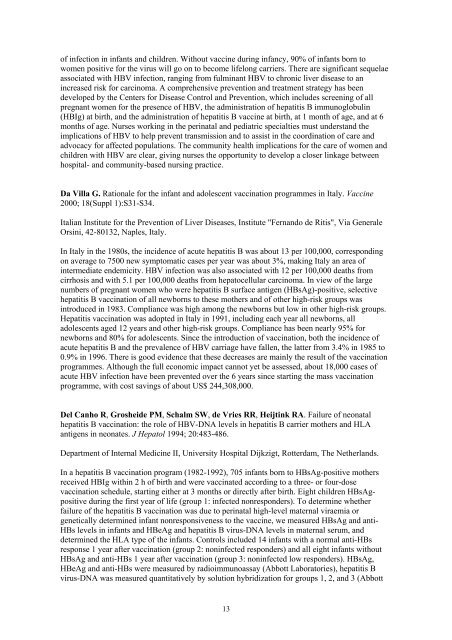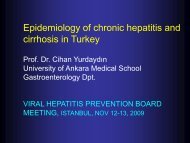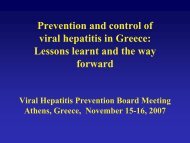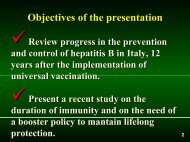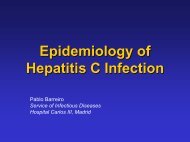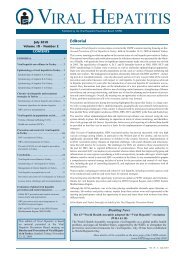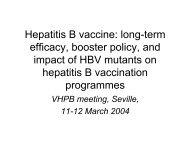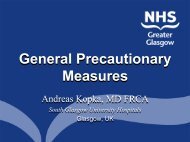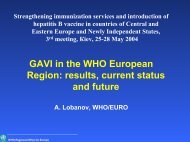Prevention and control of perinatal hepatitis B virus transmission in ...
Prevention and control of perinatal hepatitis B virus transmission in ...
Prevention and control of perinatal hepatitis B virus transmission in ...
Create successful ePaper yourself
Turn your PDF publications into a flip-book with our unique Google optimized e-Paper software.
<strong>of</strong> <strong>in</strong>fection <strong>in</strong> <strong>in</strong>fants <strong>and</strong> children. Without vacc<strong>in</strong>e dur<strong>in</strong>g <strong>in</strong>fancy, 90% <strong>of</strong> <strong>in</strong>fants born towomen positive for the <strong>virus</strong> will go on to become lifelong carriers. There are significant sequelaeassociated with HBV <strong>in</strong>fection, rang<strong>in</strong>g from fulm<strong>in</strong>ant HBV to chronic liver disease to an<strong>in</strong>creased risk for carc<strong>in</strong>oma. A comprehensive prevention <strong>and</strong> treatment strategy has beendeveloped by the Centers for Disease Control <strong>and</strong> <strong>Prevention</strong>, which <strong>in</strong>cludes screen<strong>in</strong>g <strong>of</strong> allpregnant women for the presence <strong>of</strong> HBV, the adm<strong>in</strong>istration <strong>of</strong> <strong>hepatitis</strong> B immunoglobul<strong>in</strong>(HBIg) at birth, <strong>and</strong> the adm<strong>in</strong>istration <strong>of</strong> <strong>hepatitis</strong> B vacc<strong>in</strong>e at birth, at 1 month <strong>of</strong> age, <strong>and</strong> at 6months <strong>of</strong> age. Nurses work<strong>in</strong>g <strong>in</strong> the <strong>per<strong>in</strong>atal</strong> <strong>and</strong> pediatric specialties must underst<strong>and</strong> theimplications <strong>of</strong> HBV to help prevent <strong>transmission</strong> <strong>and</strong> to assist <strong>in</strong> the coord<strong>in</strong>ation <strong>of</strong> care <strong>and</strong>advocacy for affected populations. The community health implications for the care <strong>of</strong> women <strong>and</strong>children with HBV are clear, giv<strong>in</strong>g nurses the opportunity to develop a closer l<strong>in</strong>kage betweenhospital- <strong>and</strong> community-based nurs<strong>in</strong>g practice.Da Villa G. Rationale for the <strong>in</strong>fant <strong>and</strong> adolescent vacc<strong>in</strong>ation programmes <strong>in</strong> Italy. Vacc<strong>in</strong>e2000; 18(Suppl 1):S31-S34.Italian Institute for the <strong>Prevention</strong> <strong>of</strong> Liver Diseases, Institute "Fern<strong>and</strong>o de Ritis", Via GeneraleOrs<strong>in</strong>i, 42-80132, Naples, Italy.In Italy <strong>in</strong> the 1980s, the <strong>in</strong>cidence <strong>of</strong> acute <strong>hepatitis</strong> B was about 13 per 100,000, correspond<strong>in</strong>gon average to 7500 new symptomatic cases per year was about 3%, mak<strong>in</strong>g Italy an area <strong>of</strong><strong>in</strong>termediate endemicity. HBV <strong>in</strong>fection was also associated with 12 per 100,000 deaths fromcirrhosis <strong>and</strong> with 5.1 per 100,000 deaths from hepatocellular carc<strong>in</strong>oma. In view <strong>of</strong> the largenumbers <strong>of</strong> pregnant women who were <strong>hepatitis</strong> B surface antigen (HBsAg)-positive, selective<strong>hepatitis</strong> B vacc<strong>in</strong>ation <strong>of</strong> all newborns to these mothers <strong>and</strong> <strong>of</strong> other high-risk groups was<strong>in</strong>troduced <strong>in</strong> 1983. Compliance was high among the newborns but low <strong>in</strong> other high-risk groups.Hepatitis vacc<strong>in</strong>ation was adopted <strong>in</strong> Italy <strong>in</strong> 1991, <strong>in</strong>clud<strong>in</strong>g each year all newborns, alladolescents aged 12 years <strong>and</strong> other high-risk groups. Compliance has been nearly 95% fornewborns <strong>and</strong> 80% for adolescents. S<strong>in</strong>ce the <strong>in</strong>troduction <strong>of</strong> vacc<strong>in</strong>ation, both the <strong>in</strong>cidence <strong>of</strong>acute <strong>hepatitis</strong> B <strong>and</strong> the prevalence <strong>of</strong> HBV carriage have fallen, the latter from 3.4% <strong>in</strong> 1985 to0.9% <strong>in</strong> 1996. There is good evidence that these decreases are ma<strong>in</strong>ly the result <strong>of</strong> the vacc<strong>in</strong>ationprogrammes. Although the full economic impact cannot yet be assessed, about 18,000 cases <strong>of</strong>acute HBV <strong>in</strong>fection have been prevented over the 6 years s<strong>in</strong>ce start<strong>in</strong>g the mass vacc<strong>in</strong>ationprogramme, with cost sav<strong>in</strong>gs <strong>of</strong> about US$ 244,308,000.Del Canho R, Grosheide PM, Schalm SW, de Vries RR, Heijt<strong>in</strong>k RA. Failure <strong>of</strong> neonatal<strong>hepatitis</strong> B vacc<strong>in</strong>ation: the role <strong>of</strong> HBV-DNA levels <strong>in</strong> <strong>hepatitis</strong> B carrier mothers <strong>and</strong> HLAantigens <strong>in</strong> neonates. J Hepatol 1994; 20:483-486.Department <strong>of</strong> Internal Medic<strong>in</strong>e II, University Hospital Dijkzigt, Rotterdam, The Netherl<strong>and</strong>s.In a <strong>hepatitis</strong> B vacc<strong>in</strong>ation program (1982-1992), 705 <strong>in</strong>fants born to HBsAg-positive mothersreceived HBIg with<strong>in</strong> 2 h <strong>of</strong> birth <strong>and</strong> were vacc<strong>in</strong>ated accord<strong>in</strong>g to a three- or four-dosevacc<strong>in</strong>ation schedule, start<strong>in</strong>g either at 3 months or directly after birth. Eight children HBsAgpositivedur<strong>in</strong>g the first year <strong>of</strong> life (group 1: <strong>in</strong>fected nonresponders). To determ<strong>in</strong>e whetherfailure <strong>of</strong> the <strong>hepatitis</strong> B vacc<strong>in</strong>ation was due to <strong>per<strong>in</strong>atal</strong> high-level maternal viraemia orgenetically determ<strong>in</strong>ed <strong>in</strong>fant nonresponsiveness to the vacc<strong>in</strong>e, we measured HBsAg <strong>and</strong> anti-HBs levels <strong>in</strong> <strong>in</strong>fants <strong>and</strong> HBeAg <strong>and</strong> <strong>hepatitis</strong> B <strong>virus</strong>-DNA levels <strong>in</strong> maternal serum, <strong>and</strong>determ<strong>in</strong>ed the HLA type <strong>of</strong> the <strong>in</strong>fants. Controls <strong>in</strong>cluded 14 <strong>in</strong>fants with a normal anti-HBsresponse 1 year after vacc<strong>in</strong>ation (group 2: non<strong>in</strong>fected responders) <strong>and</strong> all eight <strong>in</strong>fants withoutHBsAg <strong>and</strong> anti-HBs 1 year after vacc<strong>in</strong>ation (group 3: non<strong>in</strong>fected low responders). HBsAg,HBeAg <strong>and</strong> anti-HBs were measured by radioimmunoassay (Abbott Laboratories), <strong>hepatitis</strong> B<strong>virus</strong>-DNA was measured quantitatively by solution hybridization for groups 1, 2, <strong>and</strong> 3 (Abbott13


